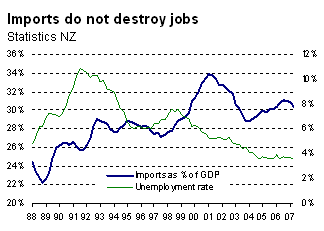"Foreign made" is in our best interest
If you haven’t seen the new poster for the "Buy New Zealand made" campaign, it features an attractively attired woman, asking the question, "Does my economy look good in this?" The implication, of course, is that we should think carefully about the damage wrought when we purchase foreign-made goods.
As an economist, I am loath to criticise a campaign that features pretty models urging us to think more about the economy. But, to my great dismay, there simply isn’t any intellectual merit to the campaign’s message. Buy all the foreign products you want – it won’t hurt the domestic economy in the slightest.
In fact, there is a common school of thought, one actively supported by current government policy, that implies that if New Zealand is to climb up the OECD economic ladder, we are going to have to buy far more imports. Let me explain.
Where exactly does the bizarre idea that imports are bad come from? Perhaps media coverage is partly to blame – whenever we hear of large-scale job losses, the reasons normally given are either businesses moving offshore or succumbing to foreign competition. However, the number of jobs lost in this manner is a small fraction of the jobs that vanish each year, which are in turn is almost always smaller than the number of jobs created. Empirically, the relationship between imports and job losses just doesn’t exist – over the last 15 years, unemployment has been trending lower even as import concentration has been increasing.

Actually, this shouldn’t surprise anyone. If we think harder about the trade process, it becomes clear that there is an error in the intuition that when foreign goods are purchased, spending power(and thus jobs) vanish from the domestic economy.
The mistake begins with the terminology. We don’t "buy" imports, we swap for them. In order to purchase that Chinese-made dress, our poster-girl first needs to find someone willing to take her New Zealand dollars in exchange for Chinese currency. But New Zealand dollars serve only one purpose – you can buy New Zealand produced goods or services(exports), or you can lend them to New Zealanders who will in turn buy New Zealand produced goods or services.
So the money does not disappear – we can only buy imports if there is someone willing to accept our exports in return, either now or in the future (if the money is used for lending). And, indeed, imports and exports tend to closely balance over the long-run. Over the last 20years New Zealand has had an average trade surplus of 0.9% of GDP.
Here we normally encounter a slightly more sophisticated complaint. When New Zealand is running a trade deficit (as is currently the case), we are borrowing from the rest of the world. The argument has been made that the New Zealand economy would grow faster if New Zealanders saved more, and the government has responded with numerous policies designed to encourage us to do so.
But regardless of whether New Zealanders’ savings are sufficient or not, buying New Zealand made still can’t impact on the trade balance. The New Zealand economy is already producing at full capacity (or more than capacity, judging by the Reserve Bank’s monetary policy stance). There aren’t any spare resources to produce more for domestic consumption, so any switch from imports to New Zealand made goods would have to be matched by a one-for-one decrease in our exports to the rest of the world. The trade balance, and thus the savings rate, would be unaffected.
To increase our savings rate, we either have to buy fewer imports full-stop, or buy less New Zealand-made goods (allowing us to export the surplus). In other words, if we wanted to redesign that poster so that the message actually made economic sense, the model would have to be wearing nothing at all.
Now that I’ve illustrated that the inexorable consequence of importing less is exporting less, hopefully it is apparent why going out of your way to buy New Zealand made is a fundamentally silly idea.
In case you’ve forgotten, we’re still in the government’s designated "Export Year 2007". Plenty of time and money is spent in an attempt to encourage and aid New Zealand companies to export more. And the New Zealand Institute has argued loudly that New Zealand desperately needs more large economic champions, exporting to the rest of the world, to boost our growth rate. Successful companies require economies of scale, and they can’t get that if they remained confined to the small New Zealand domestic market.
But unfortunately, if New Zealand’s future success requires us to export a much larger share of output to foreign markets, our import share must also rise to replace all the domestic goods we no longer make.
Existing government policy is geared towards increasing the share of output we export. The "Buy New Zealand made" campaign encourages us to increase the share of output we consume locally. I think we can all agree that it is a mathematical impossibility to do both at the same time, but nevertheless the government will be spending $11m over the next four years to convince us otherwise.




